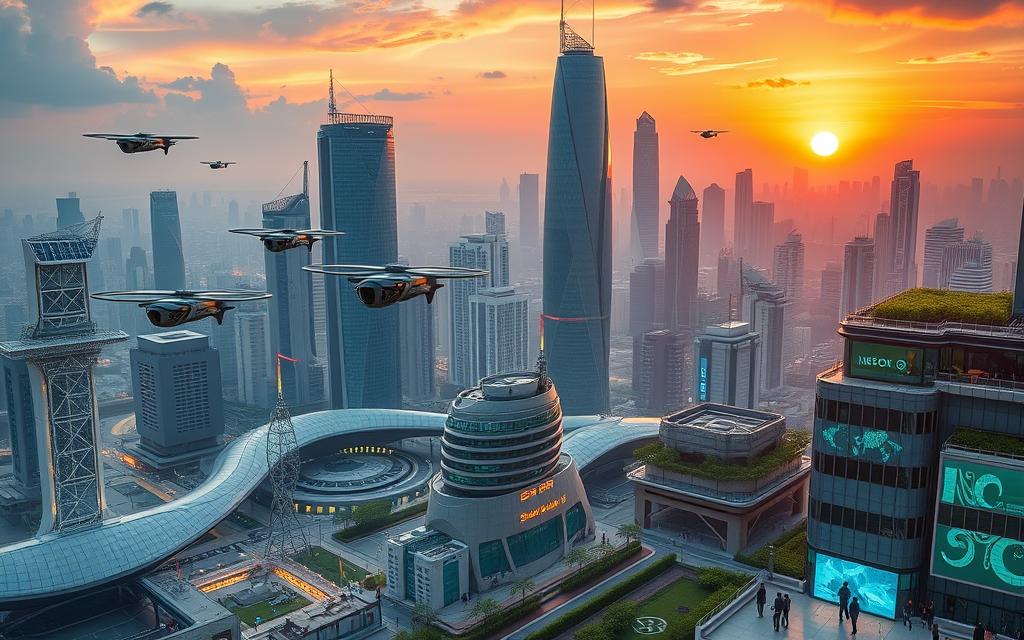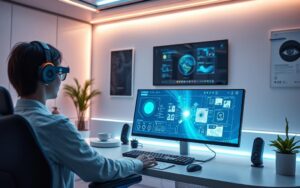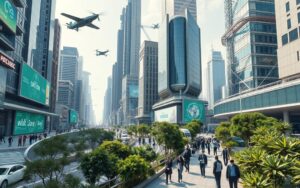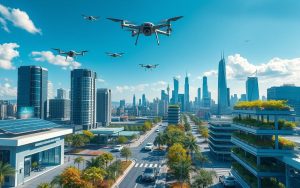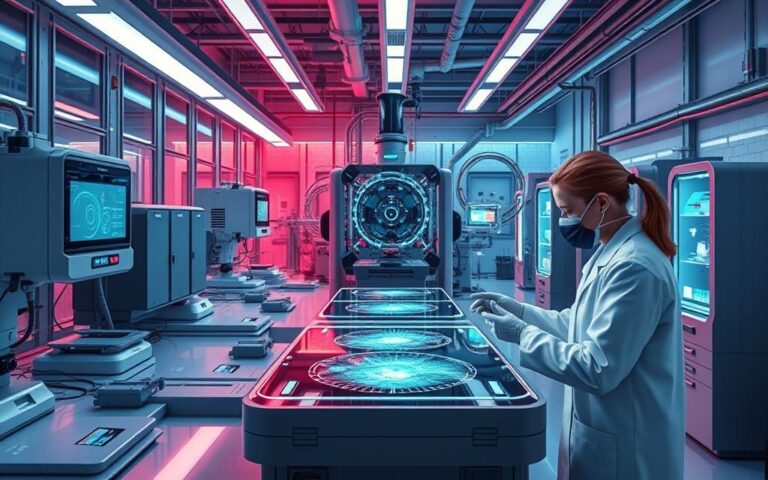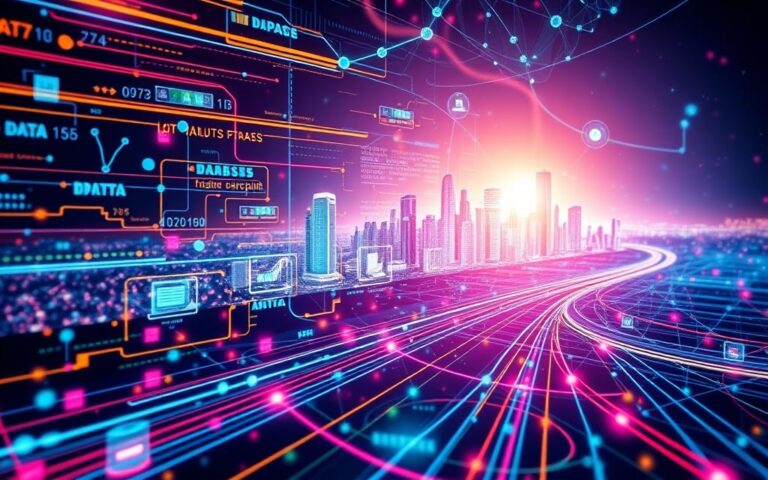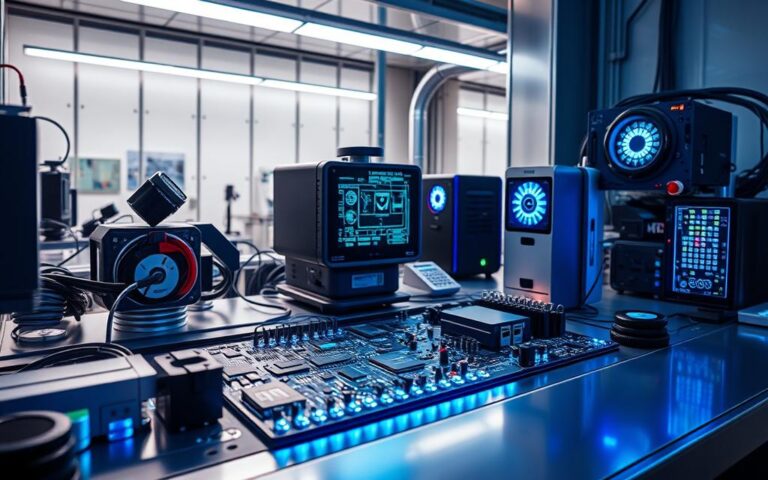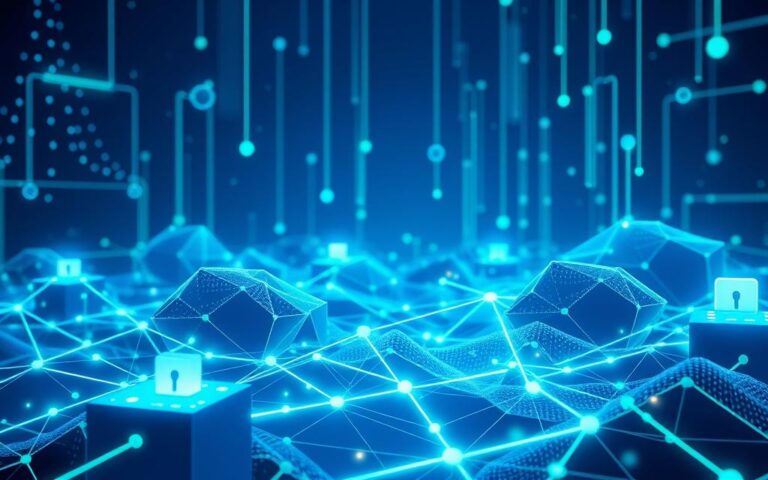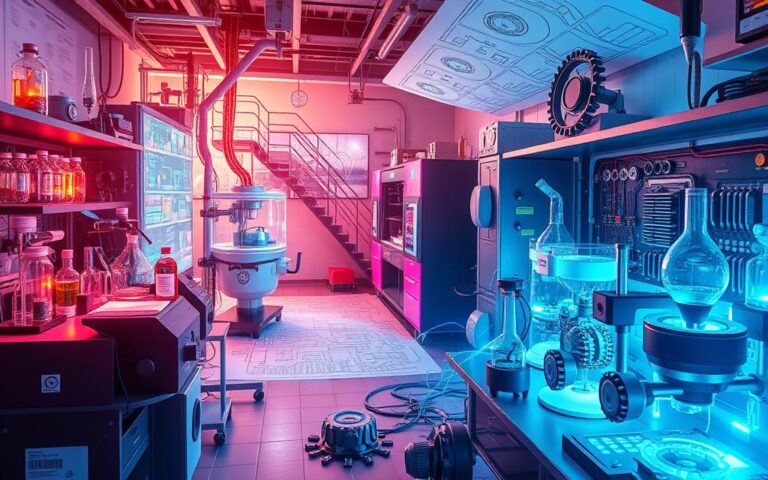How Technology Is Transforming the Modern World
Technology is changing the world fast, reshaping society. It’s making big changes in areas like healthcare and education. These changes bring new chances but also raise important questions.
For example, Shoolini University in India is leading the way in education. It’s ranked the No.1 Private University by Times Higher Education for 2024. The university is working with big names like AWS and IBM to prepare students for the future.
Technology is now a big part of our lives. It offers both challenges and great opportunities. We need to look at these changes with a critical and hopeful eye to move forward.
The Role of Technology in Sustainable Development
Technology is key to achieving sustainable development. Digital advancements bring new solutions to big challenges. For example, solar and wind power help us move away from fossil fuels, cutting down on harmful emissions.
Energy-saving technologies also play a big part. They help reduce carbon footprints in transport, buildings, and industries. Smart grids and energy storage systems make clean energy more reliable. Plus, new ways to capture and store carbon offer hope for lowering industrial emissions.
But, using these technologies is not without its challenges. Costs, infrastructure needs, and policy support are big hurdles. We need good rules and incentives to help green technologies fit into our current systems. Social efforts are also vital to change how we live and work.
Working together at a local level is important too. Community efforts help make sustainable solutions real. The mix of technology, good policies, and social action is essential for reaching our sustainable goals.
As the 2030 deadline gets closer, we must act fast. Climate Action (UN SDG 13) is a pressing issue. The cost of solar panels is dropping, making clean energy more affordable. Electric vehicles and zero-emission transport options are becoming more common, improving city air quality.
How Technology Is Changing the World
Technology is changing the world in big ways. It’s especially clear in the sustainable development goals set by the United Nations. It helps solve big problems like poverty, health issues, and education.
Technology is making a big difference in people’s lives, especially for those who need it most.
Achieving the 17 Sustainable Development Goals
Nations are using technology to meet the sustainable development goals. For example, telemedicine and mobile health apps have cut down child deaths and made people live longer.
Thanks to tech, many countries are feeding more people better. This is helping to fight global hunger.
Technology as a Great Equaliser
Technology has made it easier for people to get clean water, electricity, and sanitation. Equality through technology lets billions access things they couldn’t before.
At first, new tech is only for the rich. But, making it fair for everyone can help everyone. Smartphones and the internet are changing education and information access.
But, there are still big challenges. There are risks with new tech, especially in how we govern it. From old stone tools to today’s tech, we must make sure progress is fair for all.
We need to close the gaps as we become more connected.
| Area of Impact | Technological Advancement | Outcome |
|---|---|---|
| Healthcare | Telemedicine | Reduced child mortality and improved life expectancy |
| Agriculture | Innovative farming techniques | Higher crop yields and reduced undernourishment |
| Energy | Renewable energy technology | Improved access to clean water and electricity |
| Governance | Regulatory frameworks for technology | Mitigated risks associated with advanced technologies |
Advancements in Healthcare Technology
Healthcare technology has changed a lot, thanks to AI. It has made diagnosing and treating diseases more accurate. This has helped improve life expectancy. With new technologies coming in, we can expect even better health outcomes worldwide.
AI and Disease Diagnosis
AI has changed how we diagnose diseases. It helps doctors find conditions faster and more accurately. Machine learning looks through lots of data to find patterns we might miss.
This leads to catching diseases early. This means patients have a better chance of getting well.
- AI applications in imaging analysis
- Predictive analytics for personalised medicine
- Natural language processing for automating patient interactions
Also, electronic health records (EHRs) make it easier to access patient data. This helps doctors make better decisions. As AI gets better, it will keep making healthcare better for patients.
Improving Life Expectancy through Innovation
New technologies have helped a lot in making people live longer. They have lowered child death rates and improved health. Wearable sensors and telemedicine let us check health regularly.
This means we can catch problems early. Telemedicine is especially important in places far from doctors.
| Technology | Impact on Life Expectancy |
|---|---|
| Wearable Sensors | Continuous health monitoring for chronic conditions |
| Telemedicine | Increased access to specialist care |
| AI Diagnostics | Precision in early disease detection |
| Health Apps | Quick access to medical information |
As technology in healthcare keeps getting better, we need to keep investing. AI, telemedicine, and wearable tech are key. They offer a great chance to make life expectancy even better, leading to a healthier future.
Education in the Digital Age
Technology has changed education a lot, making digital education more accessible than ever. Now, students from all over can use virtual learning environments. This change helps make education fairer for everyone.
Virtual Learning Environments
Virtual learning lets students learn when and how they want. Sites like Khan Academy and MOOCs offer quality education online. This means anyone with internet can learn.
Learning online can be more fun and effective. New tech, like generative AI, will make it even better.
Extending Access to Excluded Populations
Technology is helping make education fairer for all. Governments and schools are working hard to include everyone. They’re improving schools in poor areas and making devices affordable.
This means more people can learn. New tech, like virtual reality, makes learning fun and interactive.
Technology can help students learn together. This change is important for a fair future. Everyone needs to support digital education to help all learners.
For more on how tech is changing education, check out this article.
Technological Impact on Employment
Technology is changing how we work. It brings new chances, especially in the green economy. Jobs that help the planet are growing, showing how work and tech can work together.
Creating New Jobs in the Green Economy
The green economy is growing fast. It’s thanks to new energy, farming, and waste tech. This growth means more jobs, from energy saving to cutting carbon.
This shift is not just about jobs. It’s also about learning new skills for a greener future.
Automation and Job Displacement Risks
Technology’s progress also brings worries, like job loss. Automation is making some jobs obsolete. This is a big concern for many workers.
Jobs at risk are often those that can be automated. This affects many workers, making them worry about their jobs.
To deal with this, we need to learn new things. Schools must teach skills for the future. This way, we can all stay relevant in a changing job world.
Data Revolution and Its Implications
The data revolution is changing how we use information in many areas. It’s making decisions and work processes more efficient. With more data being produced, thanks to new tech and online activities, big data is changing fields like healthcare, farming, and government.
This change brings new chances and big challenges. One major issue is keeping data safe and respecting people’s privacy.
The Use of Big Data in Various Sectors
In healthcare, big data helps doctors make better choices for patients. It uses machine learning to spot patterns that guide medical decisions. This is making medicine better.
Farming is also getting a boost from big data. It helps farmers grow more food with less waste. This makes farming more sustainable.
Government decisions are now based on data too. This makes services better and more responsive to people’s needs. Cloud computing is key to handling all this data quickly and easily.
Data Privacy and Personal Information Rights
Big data raises big concerns about privacy. With more data being used, there’s a risk of misuse. People want to know how their info is used.
Rules need to keep up to protect people’s rights. As we move forward, keeping data safe and handling it ethically is vital. Training staff on data privacy is also important to build trust.
The Influence of Social Media
Social media has changed how we connect and share globally. Sites like Facebook, YouTube, and Instagram help us talk and share with people all over. They let us share our lives instantly, showing how big social media’s impact is today.
Connecting Individuals Globally
Social media connects people from all walks of life. With over 101 platforms, there’s something for everyone. Mobile phones make it easy to use these apps, helping us connect worldwide.
YouTube started in 2005, and Twitter in 2006. Each has its own special features. Instagram’s photos influence what we buy. Influencers play a big role in setting trends.
Misinformation and Social Fragmentation
But social media also has its downsides, like spreading false information. Places like China and North Korea limit access, making it hard to fight misinformation. This can split societies apart.
Sinan Aral’s book, The Hype Machine, talks about these issues. Without ways to stop false news, social media can divide us more. Yet, the future of social media could bring both problems and solutions.
Technological Inequity and Accessibility
Technological inequity is a big problem worldwide. It shows the digital divide that hits many groups hard. As we move into a digital age, not everyone has equal access to the internet. This is especially true for women, the elderly, and those from less privileged backgrounds.
The Digital Divide among Populations
The digital world is not the same everywhere. In Silicon Valley, for example, there’s a big gap between the tech boom and the struggles of many workers. In 2013, the median income was $94,000, but many jobs paid less than $16 an hour. This shows how the digital divide affects people’s ability to access important resources and opportunities.
Studies show that tech can both help and hurt income equality. Countries with more internet connections tend to grow their economies faster. Yet, about 19% of Santa Clara County’s people live in poverty. This shows that not everyone gets to enjoy the benefits of new technology.
Bridging Gender and Age Gaps in Internet Access
There’s a big gap in internet accessibility between genders and ages. In the US, about 1 in 4 people have a disability, which can limit their tech access. Companies like Amazon, Apple, Facebook, and Google are making their products more accessible. This helps people with disabilities and helps close the digital divide across different ages.
We need to work together to make technology more inclusive. We should focus on making sure everyone can use the internet and understand digital tools. This way, we can make sure everyone can benefit from the digital world.
| Population Group | Poverty Rate | Median Income | Access to Internet (%) |
|---|---|---|---|
| General Population | 19% | $94,000 (Silicon Valley) | 89% |
| Women | 21% | $61,000 (National Average) | 84% |
| Individuals with Disabilities | 30% | $47,000 | 75% |
| Older Adults | 23% | $35,000 | 70% |
The Evolution of Workplaces
Workplaces have changed a lot in recent years. The Covid-19 pandemic made 93% of companies switch to remote work. This change made people focus more on mental health and finding a good work-life balance.
Digital Tools Enhancing Productivity
Technology has made workplaces more efficient. During the lockdown, 60% of UK adults worked from home. This showed how digital tools can boost productivity.
McKinsey found that 62% of companies saw more online sales. This made them rely more on digital platforms. Investments in AI have also grown, as it helps improve production.
Chatbots and smart systems are now key for staying ahead. They help create smooth customer experiences. Yet, 50% of workers need training to keep up with these changes.
Employee Well-being in a Technological World
It’s important to use technology wisely for employee well-being. Automation helps with many tasks, but human touch is still vital. AI is now used in hiring to make the process more personal.
Remote work is becoming the new standard, with 43% of Americans doing it. Flexible hours and hybrid work models are on the rise. This change pushes companies to be more inclusive and diverse.
To learn more about technology’s impact on work, check out this article.
Global Cooperation in Cyberspace
The need for global cooperation is more urgent than ever due to cyberspace challenges. Nations are often at odds, and cyberattacks threaten peace and security. The WannaCry ransomware attack in 2017 is a prime example, affecting hundreds of thousands of computers worldwide and costing over $1 billion.
This shows how crucial a unified global response is.
Challenges of Geopolitical Tensions
Geopolitical tensions spill into cyberspace, allowing malicious actors to act freely. The NotPetya attack, for instance, cost companies like Maersk up to $300 million. The Russian Federal Security Service says cyberattacks cost the global economy $300 billion yearly.
Juniper Research estimates cyberattacks could cost $8 trillion in the next five years.
The Need for Universal Digital Standards
Creating universal digital standards is essential to tackle these issues. The UN Group of Government Experts has set eleven key norms for responsible cyber behaviour. These norms aim to stop the spread of harmful technologies and protect key infrastructure.
The Global Cooperation in Cyberspace initiative supports these goals, encouraging nations to work together for a safer digital world.
Microsoft’s President, Brad Smith, stresses the importance of being open about ICT vulnerabilities. He believes nations should not exploit these weaknesses. The Global Commission on the Stability of Cyberspace has also suggested ways to improve cyber security.
These efforts highlight the importance of partnerships between governments, companies, and civil society. With backing from big names like Microsoft and JPMorgan Chase, these collaborations aim to make cyberspace more secure.
Artificial Intelligence and Ethics
Artificial intelligence is growing fast and touching many areas of life. This makes AI ethics very important. There’s a big worry about bias in AI, which could lead to unfair decisions.
Bad data can make AI systems unfair. This can make old problems worse and hurt people unfairly. We need to fix these biases to make AI fair and accountable.
Addressing Bias in AI Systems
Bias in AI is a big problem. We need to check the data and algorithms carefully. Rules and checks are being set up to help.
A study by the AI Now Institute shows how important it is to have rules for AI. Marquette University is working on making AI better, showing how education can help.
Governance of Advanced Technologies
It’s important to have rules for new tech to protect our rights. The GDPR in Europe helps by making data use clearer. The IEEE is working on making AI fairer.
Cambridge.org is finding new ways to make AI fairer. They’re using special methods to reduce bias. This helps make tech better for everyone.
| Year | Global AI Investment (USD) | Industry Focus |
|---|---|---|
| 2023 | $50 billion | Retail, Banking |
| 2024 | $110 billion | Media, Government |
| 2030 | $15.7 trillion potential GDP increase | Various |
As AI grows, we must keep ethics in mind. This will help us build a fair future. Art and tech are also changing together, with more details at this source.
Internet Connectivity and Its Benefits
In today’s fast-changing digital world, the internet changes how we connect with important services. It makes public services better in areas like education, healthcare, and government. This lets governments offer services that are more efficient and open.
Building Better Public Services
Most people think better internet will change how we get public services, making life better over the next 50 years. Digital tools help people get involved and see what’s happening, making it easier to access information and services.
- Over 85% of teachers want digital learning tools, showing how important internet is in schools.
- Telehealth services offer flexible and cheap medical care, especially for those far from cities.
- Online portals, like the Affordable Connectivity Program, make it easier to apply for social services.
Financial Inclusion through Technology
The link between financial tech and the internet helps people who don’t have bank accounts. Digital banking and mobile payments let more people join the economy. This includes those who couldn’t use traditional banks before.
| Benefit | Impact on Society |
|---|---|
| Access to Banking | Increases economic participation and security for low-income individuals |
| Digital Literacy | Improves employment opportunities in a digitally-focused job market |
| Telemedicine | Enhances access to healthcare, improving overall public health |
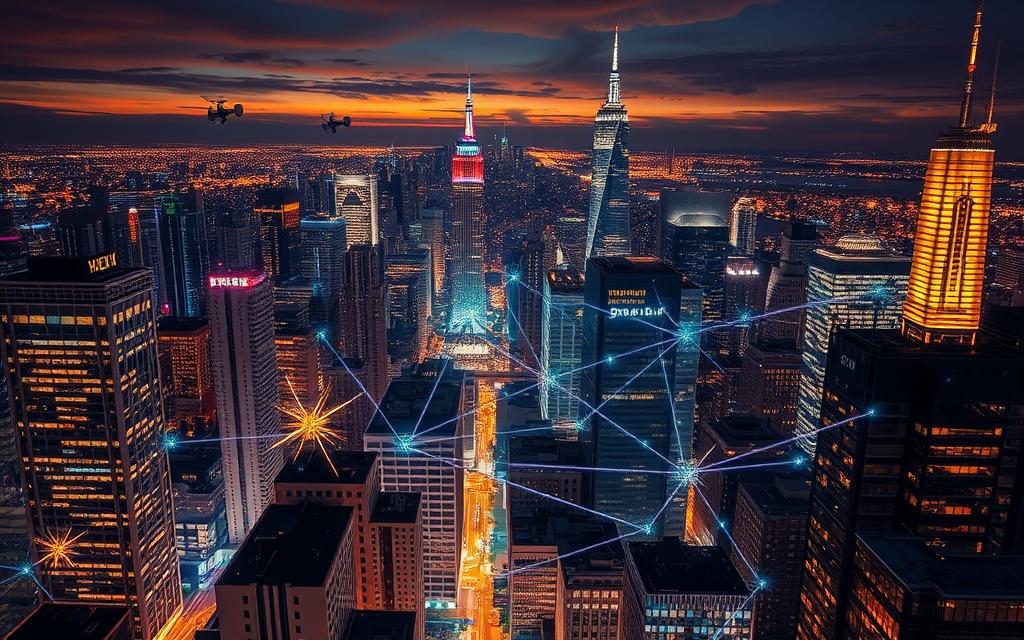
Conclusion
This journey has shown us a deep technology transformation summary. It highlights how tech has changed our lives. From the first mobile phone in 1973 to today’s smartphones, technology keeps evolving.
Smartphones, like Apple’s iPhone, have changed how we communicate. But they also raise big questions about privacy and keeping our data safe.
Looking at the future of technology, we see big changes in energy. Solar power now gives us more than 173,000 terawatts of energy every day. This shows the power of clean energy.
Also, luxury cars that are good for the planet are becoming more popular. Companies like Tesla are leading this change. This shows people want to help the environment.
As we move forward, technologies like driverless cars will change how we live and work. They will bring us closer to AI. But we must use these changes wisely. We need to make sure they help everyone and protect our planet.
FAQ
How is technology transforming the modern world?
Technology is changing many areas of life. It’s making healthcare, education, and the economy better. But, it also brings problems like privacy issues and unfairness.
What is the role of technology in achieving the Sustainable Development Goals?
Technology is key to meeting the United Nations’ goals. It helps grow economies, improves health, and makes education and money services more accessible.
How is technology a great equaliser in society?
Technology helps everyone by giving more access to resources, education, and services. This way, it promotes fairness and helps people succeed in a digital world.
What advancements have been made in healthcare technology?
Big steps forward include AI in diagnosing and treating diseases. This has led to longer lives and fewer child deaths. These advances are crucial for better health worldwide.
How has education evolved in the digital age?
Virtual learning has changed education. It makes learning possible for those who couldn’t get it before. This has opened doors to knowledge for many.
What are the employment impacts of technology?
Technology could create new jobs, especially in green fields. But, it also might replace some jobs. So, learning new skills is important for workers.
What are the implications of the data revolution?
Big data helps make better decisions in many areas. But, we need strong privacy rules to protect our data. This ensures data is used right and safely.
How does social media influence global communication?
Social media has changed how we connect worldwide. It lets us talk and work together from far away. But, it also spreads false information and can divide people.
What are the challenges of technological inequity?
The digital divide affects some groups more than others. Women, the elderly, and some communities face big challenges. We must work to make technology fair for all.
How are workplaces evolving due to technology?
Digital tools are making work better and changing how we experience it. It’s important to use technology wisely to support workers during these changes.
Why is global cooperation essential in cyberspace?
We need to work together in cyberspace because of growing tensions. Setting global digital standards helps keep everyone safe and working together.
What ethical considerations surround artificial intelligence?
We must deal with AI’s biases and create rules for fair use. This ensures AI is developed and used in a way that’s just and accountable.
How does enhanced internet connectivity benefit society?
Better internet means better public services and more financial inclusion. It’s key for improving life through digital services like online banking and telemedicine.
